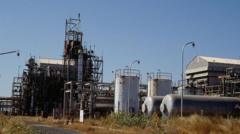After a 40-year delay, authorities have finally removed toxic waste from the site of the Bhopal gas tragedy, which killed thousands in 1984. While officials applaud the decision, activists warn of potential health risks from relocating the hazardous materials.
Bhopal Toxic Waste Removed 40 Years After Gas Leak Catastrophe

Bhopal Toxic Waste Removed 40 Years After Gas Leak Catastrophe
Cleanup efforts begin as hundreds of tonnes of hazardous waste are transported from the Union Carbide factory in Bhopal, facing scrutiny from health activists.
For the first time in four decades, Indian authorities have initiated the removal of hundreds of tonnes of toxic waste from the Union Carbide factory, site of one of the most catastrophic industrial disasters in history. The devastating gas leak in Bhopal in December 1984 resulted in the immediate deaths of approximately 3,500 individuals, while the long-term health impact has claimed the lives of over 15,000 people in subsequent years according to government estimates.
On Wednesday, authorities transported about 337 tonnes of hazardous waste to a designated incinerator facility located 230 kilometers away. This action followed a court ruling in December that mandated the disposal of the waste within a four-week timeframe. Officials indicate the treatment and destruction process may take between three to nine months to complete, yet local activists express concerns regarding the health implications for residents near the new disposal site.
The waste removed includes pesticide residues and "forever chemicals," known for their persistent toxic properties. For decades, this material had contaminated the local groundwater, posing ongoing health risks for nearby communities. A 2018 study from the Indian Institute of Toxicology Research highlighted severe contamination levels in 42 residential areas adjacent to the factory.
Despite this crucial step forward, the Madhya Pradesh High Court criticized authorities for their prolonged inactivity, labeling their previous efforts as "a state of inertia." The waste removal commenced after packing toxic materials in secure bags, which were loaded onto sealed trucks under heavy police supervision, including ambulances and fire response teams.
While officials like Swatantra Kumar Singh assure that the disposal process will not adversely affect surrounding areas, residents and activists are skeptical. Instances of pollution resulting from earlier attempts to incinerate waste at the facility in 2015 still loom large in public memory. Activist Rachna Dhingra of the International Campaign for Justice in Bhopal warns that transferring toxic waste merely relocates the problem without resolving the overarching contamination crisis, which she claims involves 1.1 million tonnes of toxic soil still leaching chemicals into the groundwater.
Previous attempts to dispose of waste have faced significant resistance, leading to plans being scrapped or relocated to various states without resolution. Although Union Carbide settled with the Indian government in 1989 for $470 million, many victims and advocates claim justice remains unfulfilled due to insufficient reparations and ongoing health effects from the gas leak.
As the cleanup efforts progress, observers around the globe continue to monitor this situation closely, emphasizing the need for a collaborative approach to fully address the health and environmental implications for the residents of Bhopal and surrounding regions.




















